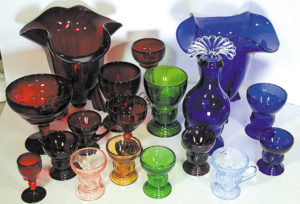 By Tom Cotter
By Tom CotterFenton photos by Barb Garrison; Fenton Mandarin Red Roberta Hankins, Cambridge and New Martinsville photos by Tom Cotter
This article continues my exploration into the grand era of color in the U.S. glass industry between 1920 and 1940 (see Mountain States Collector, September, 2018, The Colorful 20s). What could possibly happen to the U.S. glass industry during the Great Depression? Disaster? Lack of creativity and color? Hardly. While many companies within the industry declined, went out of business, or merged with others, glass firms evolved and even flourished in some instances. Other writers and I distinguish between less expensive, true “Depression Glass” and more costly and normally higher quality “Elegant Glass”.
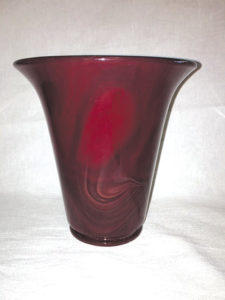 The term “Depression Glass” is now identified with inexpensive machine-produced, high-volume, “continuous tank” glass. A major innovation came along at the just the right time in 1928, as Jeannette Glass perfected the methodology for making mass production tank-based glass. Aptly, the “Adams to Windsor Depression” patterns begin and end with Jeannette designs. Even as Pattern Glass makers mimicked American Brilliant cut glass during the Victorian Era, Depression ware makers included patterns in their mold to imitate “Elegant Glass” fine etchings. This gave us dozens of lines like Cherry Blossom, Patrician (Spoke), and Sylvan (Parrot). While pinks, greens, ambers, and yellows comprised many offerings, a host of other colors included ruby, shades of blue, ultramarine, teal, amethyst and opaque colors in black, white, (Monax, Cremax, Vitrock, and milk), blue (Delphite), green (Jadeite/Jade), and solid pinks. At times, glass appeared as premiums in boxes of cereal, bags of flour, and everyday purchases such as toothpaste. Movie theaters and gas stations gave out glass as premiums. During the 1930s, Woolworth’s and other “five and dime” stores sold Depression Glass at affordable prices to brighten U.S. homes. Hazel Atlas, Hocking, Lancaster, L.E. Smith, and others brought color and interest to kitchens, dining rooms, and bedrooms throughout the U.S. when the population needed cheering.
The term “Depression Glass” is now identified with inexpensive machine-produced, high-volume, “continuous tank” glass. A major innovation came along at the just the right time in 1928, as Jeannette Glass perfected the methodology for making mass production tank-based glass. Aptly, the “Adams to Windsor Depression” patterns begin and end with Jeannette designs. Even as Pattern Glass makers mimicked American Brilliant cut glass during the Victorian Era, Depression ware makers included patterns in their mold to imitate “Elegant Glass” fine etchings. This gave us dozens of lines like Cherry Blossom, Patrician (Spoke), and Sylvan (Parrot). While pinks, greens, ambers, and yellows comprised many offerings, a host of other colors included ruby, shades of blue, ultramarine, teal, amethyst and opaque colors in black, white, (Monax, Cremax, Vitrock, and milk), blue (Delphite), green (Jadeite/Jade), and solid pinks. At times, glass appeared as premiums in boxes of cereal, bags of flour, and everyday purchases such as toothpaste. Movie theaters and gas stations gave out glass as premiums. During the 1930s, Woolworth’s and other “five and dime” stores sold Depression Glass at affordable prices to brighten U.S. homes. Hazel Atlas, Hocking, Lancaster, L.E. Smith, and others brought color and interest to kitchens, dining rooms, and bedrooms throughout the U.S. when the population needed cheering. Meanwhile, Elegant Glass companies continued to satisfy the tastes of consumers wishing “a bit more” quality and conceding more cost. Using better formulas, pot-based batches, and hand-processing including manual pressing, blowing, etching, and adding handles, feet, and/or stems, corporations such as Cambridge, Fenton, Fostoria, Morgantown, and New Martinsville continued to hold their business base. By contrast, Elegant patterns retailed through department stores such as Macy’s and through jewelry and gift shops, but occasionally through Woolworth’s and others. One major contribution to survival and growth of the Elegant glass firms came when the states repealed Prohibition in December, 1933. While decanters, stemware and steins had been produced and marketed since 1920, the repeal legitimized and encouraged lines of alcohol-related pieces. Continuous changes by these companies included new patterns, shapes, decorations, and, of course, new or renamed colors. White (milk, Moonstone, Ivory, etc.) and black (Ebony) glass offerings came from many of the companies, often as accents. New Martinsville produced Smoke, a grey transparent. Fenton in particular began to reheat glass pieces to create opalescence, as had been done by Northwood, Dugan, and Jefferson glass some years earlier. Additionally, Fenton introduced Blue Ridge in 1939, with a thin lip of cobalt glass around the top of a piece, heralding the extremely successful Crest pieces with a ribbon of contrasting color or crystal around the top edge in subsequent decades.
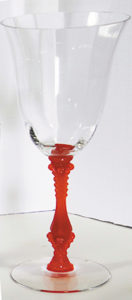 Among other choices, rich, deep purples, blues, and reds appeared in the 1930s, mostly in transparent pieces. Reversing the order in last year’s article, we look at indigo and violet glass first. Heisey Alexandrite, Fostoria Wisteria, and Cambridge Heatherbloom represented subtle neodymium-based glass changing from orchid/lavender to soft blue under different light conditions. Morgantown’s Lilac crossed over to a pale opaque. Consolidated and Phoenix produced pastel purples in a number of Art Deco lines. Vibrant purples appeared in medium to dark shades from most of the Elegant Glass companies. These included Fostoria Burgundy in addition to Cambridge and Morgantown Amethyst, all in the Violet area of the spectrum. Blue glass offerings grew, some in paler shades continued from the 1920s like Fostoria Azure, with others introduced later in the decade, including 1938 Cambridge Moonlight and Tahoe Blue. However, dark blue seemed the choice of the 1930s, some bordering on the Indigo segment of the spectrum. Among the blues were Morgantown Ritz Blue, Fenton and Cambridge Royal Blue, and various cobalt creations by Duncan-Miller, New Martinsville, Heisey, Paden City, and others. Innovative Fenton offered opaque blues with streaked Periwinkle and soft Pekin, while Cambridge countered with icy Windsor Blue. Aquamarine and teal, more commonly made by a couple of “Depression” firms, straddled the green and blue lines, including Stiegel Green by Fenton.
Among other choices, rich, deep purples, blues, and reds appeared in the 1930s, mostly in transparent pieces. Reversing the order in last year’s article, we look at indigo and violet glass first. Heisey Alexandrite, Fostoria Wisteria, and Cambridge Heatherbloom represented subtle neodymium-based glass changing from orchid/lavender to soft blue under different light conditions. Morgantown’s Lilac crossed over to a pale opaque. Consolidated and Phoenix produced pastel purples in a number of Art Deco lines. Vibrant purples appeared in medium to dark shades from most of the Elegant Glass companies. These included Fostoria Burgundy in addition to Cambridge and Morgantown Amethyst, all in the Violet area of the spectrum. Blue glass offerings grew, some in paler shades continued from the 1920s like Fostoria Azure, with others introduced later in the decade, including 1938 Cambridge Moonlight and Tahoe Blue. However, dark blue seemed the choice of the 1930s, some bordering on the Indigo segment of the spectrum. Among the blues were Morgantown Ritz Blue, Fenton and Cambridge Royal Blue, and various cobalt creations by Duncan-Miller, New Martinsville, Heisey, Paden City, and others. Innovative Fenton offered opaque blues with streaked Periwinkle and soft Pekin, while Cambridge countered with icy Windsor Blue. Aquamarine and teal, more commonly made by a couple of “Depression” firms, straddled the green and blue lines, including Stiegel Green by Fenton. Greens came in many shades and intensities, with most companies including Consolidated offering paler greens. Fenton made opaque malachite-like Mongolian Green and pale Jade (also made by Beaumont). Transparent greens ranged from rich medium offerings by New Martinsville, Paden City, Fostoria (Empire Green), and Cambridge (Forest Green) to Morgantown’s deep, shadowy Stiegel Green. Next in the rainbow is yellow, with which I have included Amber for simplification. Many firms continued these colors from the 1920s. Consolidated/ Phoenix offered pastel yellow and Honey (amber); Cambridge Gold Krystol (yellow), amber, and 1938 Mocha; Heisey Sahara (yellow) and amber; Fostoria and West Virginia Specialty Glass Topaz (yellow); Central, Fenton, New Martinsville, and others mainly amber.
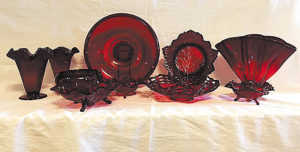 From those colors we move to orange, pink, and red. Orange remained rare, the most notable being very pricey Heisey Tangerine, while Cambridge experimented with but did not put orange into regular production. Pink colors flourished: Cambridge Peach-blo, Dianthus, and 1938 LaRosa; Fenton and Fostoria Rose; while New Martinsville, Paden City, and others made various pink pieces. A pink variation came in the 1930s when Cambridge (and Henry Hellmers) introduced flesh-toned opaques Crown Tuscan and Coral. Hellmers also developed a similar Aladdin Alacite mixture later in the decade, but with uranium salts included. About 1939, Fenton began making a Cranberry color, which would become a major company boost throughout its extended future. Among transparent “red-reds” were ruby shades by Duncan-Miller, Fenton, Fostoria, New Martinsville, Paden City, and West Virginia Specialty Glass. Cambridge attached the label Carmen to their “full-bodied” red. Morgantown used Spanish Red. Variation among these reds was substantial, from deep crimson to sullen blood red. Fenton reissued opaque Mandarin Red in a number of stunning decorative pieces. I cannot guarantee that you will find all there colors at the Front Range Glass Show September 21 and 22 at the Ranch Events Complex near Loveland, but I do assure you there will be exceptional American glass, pottery and china from the 1800s through 1980. Jodi and Mark Uthe have again gathered a great lineup of dealers from across the country. Also, there will be exhibits to nudge your interest. My thanks go to Peggy and Jon DeStefano for providing
From those colors we move to orange, pink, and red. Orange remained rare, the most notable being very pricey Heisey Tangerine, while Cambridge experimented with but did not put orange into regular production. Pink colors flourished: Cambridge Peach-blo, Dianthus, and 1938 LaRosa; Fenton and Fostoria Rose; while New Martinsville, Paden City, and others made various pink pieces. A pink variation came in the 1930s when Cambridge (and Henry Hellmers) introduced flesh-toned opaques Crown Tuscan and Coral. Hellmers also developed a similar Aladdin Alacite mixture later in the decade, but with uranium salts included. About 1939, Fenton began making a Cranberry color, which would become a major company boost throughout its extended future. Among transparent “red-reds” were ruby shades by Duncan-Miller, Fenton, Fostoria, New Martinsville, Paden City, and West Virginia Specialty Glass. Cambridge attached the label Carmen to their “full-bodied” red. Morgantown used Spanish Red. Variation among these reds was substantial, from deep crimson to sullen blood red. Fenton reissued opaque Mandarin Red in a number of stunning decorative pieces. I cannot guarantee that you will find all there colors at the Front Range Glass Show September 21 and 22 at the Ranch Events Complex near Loveland, but I do assure you there will be exceptional American glass, pottery and china from the 1800s through 1980. Jodi and Mark Uthe have again gathered a great lineup of dealers from across the country. Also, there will be exhibits to nudge your interest. My thanks go to Peggy and Jon DeStefano for providing 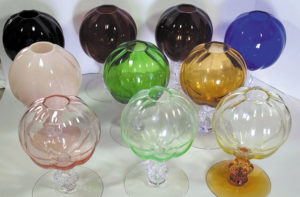 information and interest in our region with the Mountain States Collector. Information for the show is on the Rocky Mountain Depression Glass Society website, where our meeting and our library information can be found at www.RMDGS.com. This also links to http:// www.frontrangeglassshow.com/, which has more specifics about the show. We hope you cruise malls, shops, and shows in Colorado and adjoining states. Enrich your lives with color, beauty, and a bit of history.
information and interest in our region with the Mountain States Collector. Information for the show is on the Rocky Mountain Depression Glass Society website, where our meeting and our library information can be found at www.RMDGS.com. This also links to http:// www.frontrangeglassshow.com/, which has more specifics about the show. We hope you cruise malls, shops, and shows in Colorado and adjoining states. Enrich your lives with color, beauty, and a bit of history.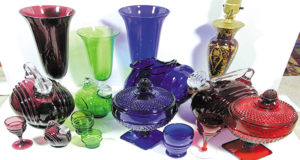















Follow Us